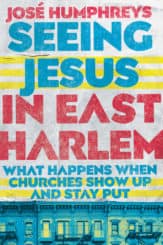
I love the local church, with all its hopes, dreams, and beautiful letdowns. Like a good dojo, she can be a rigorous space for learning how to love—a space for knowing God more through the practice of loving others well. And if truly open, the church can also be a space to experiment as we follow the Spirit’s lead into new approaches to living, sharing, and showing signs of God’s good news in our world.
Over the last eleven years or so I’ve had the privilege of leading a small, nimble, evangelical, ecumenical, multiethnic, transient church in East Harlem. I believe like many other churches across cities, towns, and countries, we are a community leaving a beautiful imprint in our place. We have cultivated a family defined by God’s work through our presence at one of the busiest intersections of the globe.
We have cultivated a family defined by God’s work through our presence at one of the busiest intersections of the globe.
Life on the conveyor that is NYC can make the island feel more like a port of call than a destination. People come and go. Narratives converge (or collide) in a place where the pace can prove antithetical to fostering deep community and transformation. I remember some time ago a pastor friend lamented over breakfast, “If the typical Manhattan person attends church about thirty Sundays per year for about one-and-a-half hours, an equivalent of forty-five hours, what kind of transformation can we truly expect?”
Like him, I often lament the institutional church’s diminished role in society. Yet embedded in this challenge I envision an opportunity to reimagine our collective togetherness as part of God’s larger plan for the way we live in the world—both huddled together and scattered forth after Sunday’s benediction.
I’ve spent the last decade trying to figure out those forty-five hours in context. All the while I’m escaping the gravitational pull of the “good ol’ days”—the times when church was a family’s biggest priority, when church was for better or worse closer to the center of people’s life rhythms. Now with the church largely decentered, I spend the majority of my time teaching others how to live as followers of Christ. I take a self-reflective, formative approach to serving hopefully, anchoring people in practices and postures rooted in God’s good news.
Through the life of Christ, the Scriptures demonstrate how discipleship is just as intentional as it is incidental, even improvisational—through casual conversations over tables, walks in the community, being touched by suffering, and many other encounters beyond our Sunday venues, shaping us to become nimble and responsive to God’s daily assignments.
This discipleship, viewed through a more generous gospel prism, can propel us into a wider reaching, more vigorous faith. Meanwhile, the practices of this faith can feel like the downward facing dog of the soul; while the posture looks easy enough, in practice it’s difficult to sustain. But true faith dismantles illusions of false comforts and paper-thin theologies. The Spirit of God reminds us how adventures in growth are not without degrees of discomfort and tension. In truth, the Spirit’s presence will draw us, even propel us, into paths less traveled—what the Bible describes as a narrow road.
In writing as a pastor, the “first disciple” of the local church, I have marked a path as a faithful practitioner in my context. This book should not be read as a one-stop, prepackaged what-to-do-for-ministry tool, but with an eye toward seeing and living more robustly in our calling to engage the crossroads of identity, race, diversity, and vocation (to name a few).
Serious discipleship is about how God’s Spirit can breathe healing and inspire new imagination into our immediate realities. A vision for deeper discipleship, then, is a necessity, and God’s guest list will include all sorts of strange people who might not typically belong together. Together, we can witness signs and snapshots of the kingdom if we learn to show up and stay put.
Together, we can witness signs and snapshots of the kingdom if we learn to show up and stay put.
Indeed it will be tough to stay put as we fumble around together, in a way reminiscent of the first church of Acts: steps behind God’s Spirit, in tension with culture, perceived as never keeping up with the latest thinking. Moving together as a family will never happen quickly enough, packing for trips is stressful, and agreeing on the best path forward can be tension-ridden—enough to keep us home settling for a movie and popcorn. But who wants to stay home and spectate?
Here’s my conviction about church ministry: whether big or small, whether a church lasts with legacy or stays around for only a season, we can’t settle for being holding spaces for mere rituals. We are called to be God’s experiment in how people stay together in a divided world. Now more than ever—whether churches are in city, town, or country—we need churches that will dismantle the walls of hostility that keep us apart, uncoiling people from shame and hiding, allowing God’s very good news to unfurl us all into our full humanity as image bearers. I am grateful to play a small part in such a grand and heavenly enterprise.
Today’s world requires a deeper discipleship for the glory of God and the good of our global family. Not only for our own sake, but for the sake of future generations who will eventually show up for God’s invitation.
 The Reverend José Humphreys is a facilitator and pastor of Metro Hope Covenant Church, a multiethnic church movement in East Harlem, New York City. He is involved in shalom-making in New York City through facilitating conversation, contemplation, and action across social, economic, cultural, and theological boundaries. He is the author of Seeing Jesus in East Harlem: What Happens When Churches Show Up and Stay Put, from which this excerpt is taken with permission from InterVarsity Press.
The Reverend José Humphreys is a facilitator and pastor of Metro Hope Covenant Church, a multiethnic church movement in East Harlem, New York City. He is involved in shalom-making in New York City through facilitating conversation, contemplation, and action across social, economic, cultural, and theological boundaries. He is the author of Seeing Jesus in East Harlem: What Happens When Churches Show Up and Stay Put, from which this excerpt is taken with permission from InterVarsity Press.


